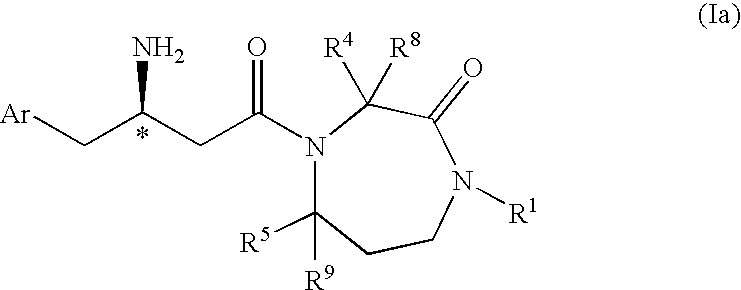Beta-amino heterocyclic dipeptidyl peptidase inhibitors for the treatment or prevention of diabetes
a technology of beta-amino heterocyclic dipeptidyl peptidase, which is applied in the direction of peptides, drug compositions, metabolic disorders, etc., can solve the problems of increased and premature morbidity and mortality, increased risk of macrovascular and microvascular complications in patients with type 2 diabetes mellitus, and increased risk of macrovascular and microvascular complications
- Summary
- Abstract
- Description
- Claims
- Application Information
AI Technical Summary
Benefits of technology
Problems solved by technology
Method used
Image
Examples
second embodiment
[0060]In the compounds of the present invention, R3 is selected from the group consisting of[0061]hydrogen,[0062]halogen,[0063]cyano,[0064]hydroxy,[0065]C1-6 alkyl, unsubstituted or substituted with one to five halogens, and[0066]C1-6 alkoxy, unsubstituted or substituted with one to five halogens.
In a class of this embodiment, R3 is selected from the group consisting of hydrogen, fluoro, chloro, bromo, trifluoromethyl, and methyl. In a subclass of this class, R3 is selected from the group consisting of hydrogen, fluoro, and chloro.
third embodiment
[0067]In the compounds of the present invention, R1 is selected from the group consisting of:[0068]hydrogen,[0069]C1-6 alkyl, wherein alkyl is unsubstituted or substituted with one to five substituents independently selected from halogen, hydroxy, C1-6 alkoxy, carboxy, C1-6 alkyloxycarbonyl, and phenyl-C1-3 alkoxy, wherein alkoxy is unsubstituted or substituted with one to five halogens,[0070](CH2)n—C3-6 cycloalkyl, wherein cycloalkyl is unsubstituted or substituted with one to three substituents independently selected from halogen, hydroxy, C1-6 alkyl, and C1-6 alkoxy, wherein alkyl and alkoxy are unsubstituted or substituted with one to five halogens; and[0071]wherein any methylene (CH2) carbon atom in R1 is unsubstituted or substituted with one to two groups independently selected from halogen, hydroxy, and C1-4 alkyl unsubstituted or substituted with one to five halogens.
[0072]In a class of this embodiment of the compounds of the present invention, R1 is selected from the group ...
fourth embodiment
[0083]In the compounds of the present invention, R4 and R5 are independently selected from the group consisting of:[0084]hydrogen,[0085]C1-10 alkyl, unsubstituted or substituted with one to five substituents independently selected from halogen, hydroxy, C1-6 alkoxy, carboxy, C1-6 alkyloxycarbonyl, and phenyl-C1-3 alkoxy, wherein alkoxy is unsubstituted or substituted with one to five halogens,[0086](CH2)n-aryl, wherein aryl is unsubstituted or substituted with one to five substituents independently selected from halogen, hydroxy, C1-6 alkyl, and C1-6 alkoxy, wherein alkyl and alkoxy are unsubstituted or substituted with one to five halogens,[0087](CH2)n-heteroaryl, wherein heteroaryl is unsubstituted or substituted with one to three substituents independently selected from hydroxy, halogen, C1-6 alkyl, and C1-6 alkoxy, wherein alkyl and alkoxy are unsubstituted or substituted with one to five halogens,[0088](CH2)n-heterocyclyl, wherein heterocyclyl is unsubstituted or substituted wi...
PUM
| Property | Measurement | Unit |
|---|---|---|
| volume | aaaaa | aaaaa |
| emission wavelength | aaaaa | aaaaa |
| excitation wavelength | aaaaa | aaaaa |
Abstract
Description
Claims
Application Information
 Login to View More
Login to View More - R&D
- Intellectual Property
- Life Sciences
- Materials
- Tech Scout
- Unparalleled Data Quality
- Higher Quality Content
- 60% Fewer Hallucinations
Browse by: Latest US Patents, China's latest patents, Technical Efficacy Thesaurus, Application Domain, Technology Topic, Popular Technical Reports.
© 2025 PatSnap. All rights reserved.Legal|Privacy policy|Modern Slavery Act Transparency Statement|Sitemap|About US| Contact US: help@patsnap.com



